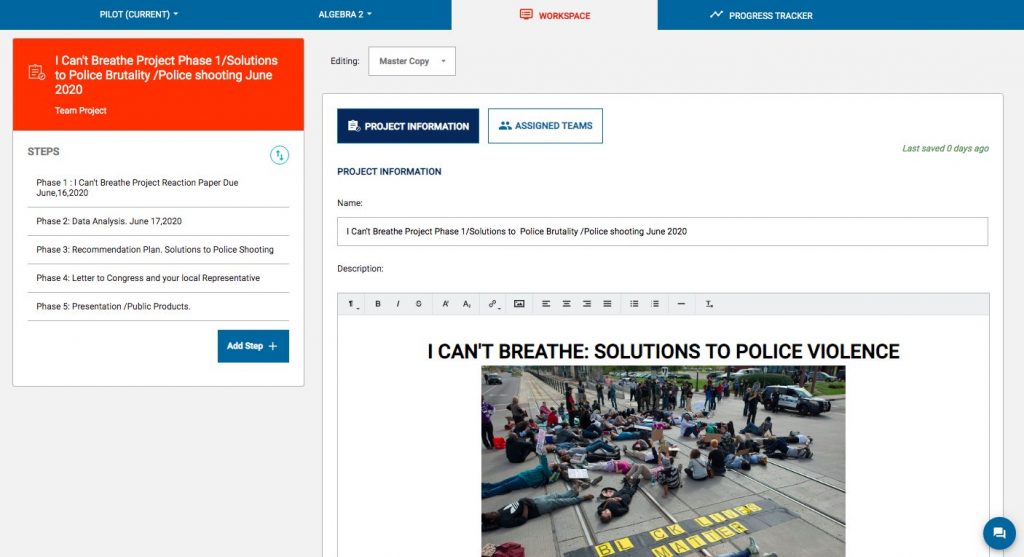By. Sanch Lawrence
I vividly remember my last in-person class before COVID-19 upended school as we know it. It was March 13, 2020, the day before Pi day. I was teaching a lesson on simplifying a rational expression to my eleventh-grade Algebra 2 students at Clara Barton High School in New York City. Students were casually discussing a Facebook post about COVID-19 as they worked in groups practicing problems in preparation for the upcoming Algebra 2 regents exam. Meanwhile, my coworkers and I were discussing the possibility of school being canceled for a few weeks or possibly the rest of the school year.
No one fully understood the health implications of COVID-19 and the impact it would have on in-person learning. And no one could’ve anticipated how the shift to remote learning would change the landscape of education, specifically how educational technology (ed-tech) would become essential to learning. Like water shapes itself to a vessel, educators had to transition from the traditional “chalk and talk” way of instruction to become smart-board, tech-savvy teachers. While challenging, this transition provided an opportunity for educators like myself to experiment with synchronous and asynchronous methods of teaching, as well as test out a host of ed-tech tools. For example, Zoom became a favorite among educators because of its breakout rooms, polling, and security features. Ed-tech tools quickly transformed the laptop screen into a classroom, where teachers, students, and parents could co-create a productive and collaborative online learning community.
I faced a couple of key challenges in transitioning my math classroom to a remote learning environment. My top priority was establishing a virtual classroom that accommodated multiple learning styles to ensure all my students had access to and could complete their assignments. Then came the challenge of covering what remained of the eleventh-grade math content for that year. I was personally challenged to find a way to deliver that content so it connected students to current events. The death of George Floyd, coupled with COVID-19, touched a nerve in students and stirred up strong feelings that needed to be expressed. Many of my students are aware of police violence in their neighborhoods and have experienced it themselves. How could I give my students an opportunity and an outlet to explore these issues while teaching math and meeting their multiple learning styles? The answer was project-based learning (PBL). PBL was a natural way to address these challenges; however, I had never used PBL in a virtual environment before.
I became a PBL Practitioner after attending hours of training offered by the New York City Department of Education’s Academic Integration Network and the Cloud Institute for Sustainability Education. I turned to these organizations again as I began to think more deeply about how I could facilitate authentic learning experiences in a virtual classroom that were personalized, interest-based, student-designed, and self-directed, all components of good PBL. Together, we designed interdisciplinary projects with themes that were designed to offer student choice. My class ultimately opted to do a project called “I Can’t Breathe,” the goal of which was to provide students with an opportunity to examine social issues like police violence, police corruption, and police misconduct. For this project, students analyzed raw statistical data found in the Washington Post’s Police Shootings Database and used that data to formulate concrete solutions. With guidance from their ELA Teachers, students also wrote letters to Congress regarding the need for police reform.

To successfully involve other educators in this project, I realized I needed a digital platform that would facilitate PBL in a virtual space. One of the most time-consuming tasks was deciphering which ed-tech tool would facilitate and enhance PBL without undermining its effectiveness. After some trial and error, my team eventually settled on a digital learning platform called LiFT. LiFT is specifically designed to carry out interdisciplinary, real-world projects that feature student voice and choice, engaging students and educators in co-creatively designing a collaborative learning journey. The process is pretty simple. Either students or teachers can launch a project and evidence is uploaded for feedback and revision. Once complete, evidence is pushed to the appropriate ‘skill portfolio’ where mastery can be assessed holistically. Students can track their growth, too, encouraging them to take ownership of their learning.
Although LiFT supports student-directed projects, I chose to kick-off my inaugural project by outlining the basic scope and sequence for my students. Their first task was to write a reaction paper based on a selection of articles they read on police violence. Students uploaded their draft reaction papers on LiFT and worked with their ELA teacher to revise their drafts based on feedback they received. Next, students analyzed data found in the Police Shootings Database by race, state, level of threat, etc. using various math tools. They then used LiFT to integrate their data analysis into the project’s next step, which was writing a letter to Congress. During this phase of the project, students used LiFT to give feedback to peers on their draft letters. This feedback was valuable as it not only strengthened the students’ final products but encouraged them to take other perspectives into account and be more flexible in their writing. As a class, we adapted and personalized the project along the way, curating new learning resources and discussing our findings on LiFT’s chat-based feedback forum. To wrap things up, students shared their findings during a virtual presentation with educators, peers, and family members and engaged in evidence-based discussions.
A key takeaway from this first foray into virtual PBL is that students are willing to become agents of change and advocate for social justice wherever learning occurs – whether in a classroom or at the kitchen table. It’s at the discretion of the educator to marry content with PBL to stimulate student interest. Our final showcase stimulated interest among my colleagues in PBL without trying. I’ve received several emails from fellow educators expressing a desire to create virtual, interdisciplinary PBL projects in the future. We are currently in the process of creating an online educator community that connects ed-tech tools and PBL.
Remote learning is here to stay in schools, in one form or another. COVID-19 only accelerated the path while exposing the hurdles we need to leap to fully master this method of teaching and learning. We’ve learned a lot over the last six months. I expect to continue that learning well into this next school year. The use of new technologies, like LiFT, gives educators like me an opportunity to be creative and explorative in our practice and with our curriculum. I look forward to further experimentation with ed-tech tools in the months ahead and finding new ways to engage students in PBL projects in my virtual classroom.
For more information about LiFT, contact david@liftlearning.com.
Author Bio
Sanch Lawrence has ten years of experience in education, teaching subjects from mathematics to computer programming in New York City public schools and at the City University of New York. She is currently working with the New York City Department of Education’s Academic Integration Team and Workplace Challenge Team to create virtual workplace challenge programs for teachers, student community organizations, and network partners in response to COVID-19. Sanch also works as an Assessment-AP Coordinator and math teacher at Clara Barton High School in Brooklyn, New York.

